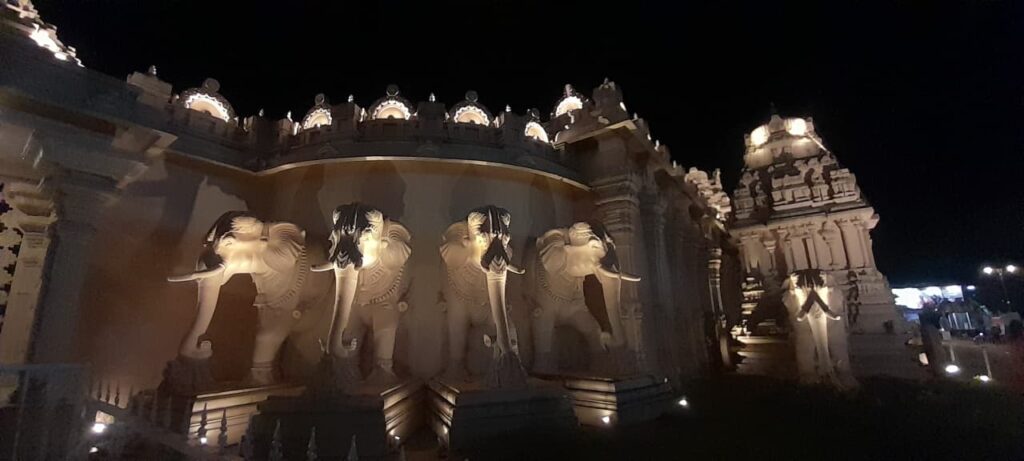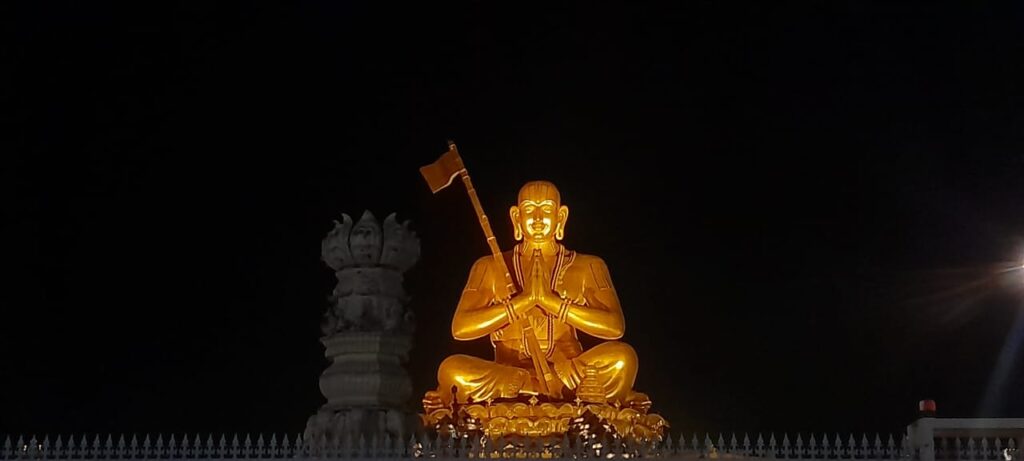Statue of Equality: The Inspiring Beacon of Unity and Hope
- 3 Views
- Urvi
- November 6, 2025
- Travel Stories
Statue of Equality – Distance and the Journey

We stay in Manneguda, Telangana — a quiet little pocket that’s close enough to the city yet far enough to escape the Hyderabad hustle. The Statue of Equality is just a few dozen kilometres from our place, so we kicked off our ride around 6:30 pm. There are smooth roads all the way, But light arrangements are not working at many points. Those stretches? A perfect mix of eerie calm and cozy solitude. It happens, right? When you somehow do not like the dark. You simply hold on to your partner even tighter and absorb the natural soft light of the night. The trees planted on either side look even greener. Clouds flying on the night skyscape. This is nature’s appetiser.
Since we were riding parallelly expressway or highway, the traffic wasn’t completely absent. But the late evening winds in Hyderabad are a little cold. I wish to had worn a light jacket while I was riding as pillion with Mahi on our ‘Garuda’. The tip is to hold your partner to help yourself keep warm, also helping him with the same warmth. It took us almost an hour to get to the Statue of Equality.
As it was post-Diwali time, the lighting of the campus mesmerised us with its décor. The 216-foot-tall, five-metal sitting statue of the 11th-century saint Sri Ramanujacharya was the centre of attraction. The Statue of Equality in Hyderabad is dedicated to his message of equality and social justice.
Also Read: Is Birla Mandir Hyderabad’s most loved temple?
For some reason, the crowd at that time was minimal. We parked our motorcycle, and I asked a personnel member there how to visit the temple and about the attractions of the place that it offers. He guided us to take a ticket to enter the temple.
Statue of Equality – Tickets
We went ahead to search the ticket counter, but before we were pulled by the glorious appearance of the Statue of Equality, i.e., Statue of Saint Sri Ramanujacharya and the intricately illuminated premises that we stopped by and clicked some photographs for our Telangana tourism memories.
The outer premises offer beautiful carvings of elephants and raths, and two tall statues of Lord Garuda and Lord Hanuman on either side of the gate. To the left side is a room from which we can get our tickets. The room has many ticket vending machines to self-buy the tickets using UPI Options. Cash holders can also buy a ticket from a separate space within the same room itself. A ticket of 250 rupees for adults.
Statue of Equality – Dresscode
There is no specific dress code to visit the Statue of Equality. A modest outfit is sufficient. Since I was wearing a sleeveless frock, a few women out there asked me to purchase a dupatta for rupees 100 to cover my bare arms. I covered them with the scarf I already had. And from there we went ahead to attend the evening arti called as Samatha Neerajanam, which was an experience in itself.
Before that, we had to deposit our footwear and mobile phones at counters made for their deposits and collect the token from the same. We didn’t pay anything apart from the 250 rupees, once paid at that time only. Next, there was a security check that we had to pass through. They stamped our wrists with OM and SOE stamps.
Statue of Equality – Aarti and Laser light show

Finally, we rushed to attend the arti whose sound was inviting our ears. The evening arti had already begun, and we were running late by 5-7 minutes. We rushed and finally reached the space that was right in front of the 216-feet-tall statue of Saint Sri Ramanujacharya, right between the space below the stairs and Garuda Stambh.
10- 12 men and women were performing the arti with the art thalis that had various diyas. These people were wearing beautiful and identical clothes. Females were wearing shiny bright coloured sarees, and men were wearing kurta pajama sets. Both looked eye-catching. They were doing arti with an offering of a certain dance form. After them were standing saints of different age groups, who also joined them in the arti later.
A few of the devotees were seen doing arti with a specific diya given to them for arti. The prayer took all our hearts. With the flower scattered, arti smoke and chants of lord Shrimannarayan (another name of our Lord Ram), the whole atmosphere felt simply divine.
With the passage of time and age, I realised that my liking towards such religious spaces and gatherings has evolved and grown. I am liking spending time with such religious happenings with high-energy chants and lighting of diya and hawans. I believe these spiritual activities have magical impacts on our nervous system. It boosts our ability to forget the rubbish of our lives and relish all the positives that each of us already has in abundance.
Lord Srimannarayan was taken on the wooden chariot, placed on two bamboo sticks held on the shoulders of two muscular men who were disciples. The other two were holding the two chatris that held high above the head of the lord. A whole procession of other 20 -25 saints did a parikrama of the Stambh, and finally, the chariot was taken to the temple where the statue of the god was to be placed.

The Samatha Neerajanam (arti) was followed by a Laser and fountain show – Leela Jala Neerajanam. It was shown on the Garuda Stambh. It was a show with the story of 11th-century saint Sri Ramanujacharya, with music, and the fountain that was placed beautifully around the stambh was performing ‘water works. Just like a child, I was more captivated by the water works there than the story of the saint. The amalgamation of colours, light, and water was something every one of us present there would have taken home in their memories.
Statue of Equality – Saint Sri Ramanujacharya
Then we turned around and started climbing up the 108 steps that took us to the base of the lotus on which a 216-foot-tall, five-metal statue of the 11th-century saint Sri Ramanujacharya was sitting. We were awestruck to see the statue that was made of a mixture of five metals: gold, silver, brass, copper, and zinc. It commemorates Ramanujacharya’s 1000th birth anniversary and promotes his philosophy of equality, regardless of caste, faith, or gender. An elevator facility is also available.

The statue of equality is built on a 54-foot-high base building called the “Bhadra Vedi,” which houses a Vedic digital library, a research center, a theater, and an educational gallery.
The lotus is placed on the elephant from all sides. These elephants are also fountains as water was coming out of their mouth. From the top, the vicinity was dark. So, the immensely lit statue was looking wow amidst that darkness. Below is a big circular hall in which a gold statue of the saint is placed for worship. The pujari there puts a bell-shaped mala on the head of devotees and chants Srimannarayan in blessings.
Statue of Equality – 108 temples
We descended, and from there we started to visit 108 Divya Desams (model temples) that surround the area around the statue. These are 108 replicas of ancient Vishnu temples, which are significant in Vaishnavism. Divya means “divine” and Desam means “place of abode” (temple). Dark black stone temples looked heavenly at those hours of the night.
I saw reclining Vishnu in the 1st divya desam we started with. Mahi and I together spoke ‘Padhmanabham Swamy’, to which the pujari there corrected us that this shrine is not of the one we spoke about, Padhmanabham Ji was in divya desam no 74 or something like this.
So all the small black stone temples – divya desam had Vishnu Bhagwan worshipped in different parts of Bharat and outside the country. Dwarika’s Dwarikadheesh, Ayodhya’s Ram Darbar, Nepal’s Muktinath, Tirumala, etc, to name a few. I was mesmerised to see Vishnu Bhagwan is worshipped in various appearances. Each one of them adorned different and delicately done vastra – attires and twinkling jewelleries in the light of diyas lit inside the temple’s space- garbh greh.
Black temple, black Vishnu in the divinely lit diya lamps – my mind, body, heart & soul absorbed everything beautifully. Vishnu has given me his own colour – black. I feel blessed to be in that divine black.
After visiting the 108th temple, the walkway takes you to the exit area. In the middle of it was a counter which offered prasad – tamarind rice in a leaf bowl. We also purchased mysore pak – 2 pieces of rupees 50 and a 1 laddoo of rupees 50 from the prasad counters in between visiting the divya desam.
Then the way led us to an area where a few outlets selling souvenirs, etc, were placed. We also savoured tasty millet ice cream. Custard apple and guava flavours are our recommendations. Then we collected our mobiles and footwear and came to the front area premises of the enormous statue once again and took some more pictures. Since the crowd that day that time was very minimal, all our experiences were very smooth, soothing, and satisfying.
Take a refillable water bottle, as there are many water filling counters inside. Go in the evening around 4 or 5 pm so you get both the day and night views. Clean restrooms are available inside the complex. You need to leave your phone and shoes at Gate 1 and collect them at the exit at Gate 8.
The Conclusion
Definitely, the statue of equality, Hyderabad, is worth a visit. People of all age groups will find their areas to feel wholesome. Golf cart and wheelchair facilities are also available for the needy. The premises also have a small playground to keep your little ones engaged. So when in Hyderabad, take out some time for this wonder too.